Thank you for visiting nature.com. You are using a browser version with limited support for CSS. To obtain the best experience, we recommend you use a more up to date browser (or turn off compatibility mode in Internet Explorer). In the meantime, to ensure continued support, we are displaying the site without styles and JavaScript.
- View all journals

Nutrition articles from across Nature Portfolio
Nutrition is the organic process of nourishing or being nourished, including the processes by which an organism assimilates food and uses it for growth and maintenance.
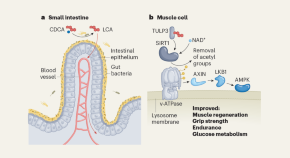
A bile acid could explain how calorie restriction slows ageing
Could lithocholic acid, a compound produced when gut bacteria process bile, be the missing link between a low-calorie diet and its age-defying effects? Experiments in mice, flies and nematode worms provide clues.
- David A. Sinclair
Latest Research and Reviews
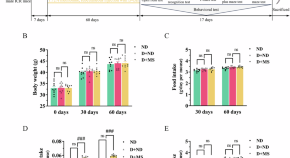
Dietary methionine supplementation improves cognitive dysfunction associated with transsulfuration pathway upregulation in subacute aging mice

The effect of a new developed synbiotic yogurt consumption on metabolic syndrome components in adults with metabolic syndrome: a randomized controlled clinical trial
- Mohammad-Amin Zolghadrpour
- Mohammad-Reza Jowshan
- Somayyeh Asghari
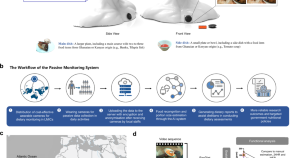
AI-enabled wearable cameras for assisting dietary assessment in African populations
- Frank P.-W. Lo
- Jianing Qiu
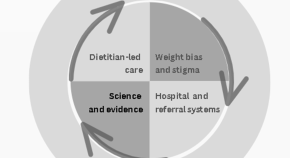
Exploring dietitians’ experiences caring for patients living with obesity in acute care: a qualitative study
- Andrea Elliott
- Simone Gibson
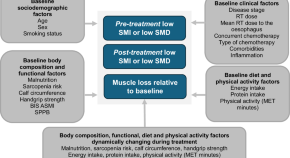
Sociodemographic and clinical factors associated with low muscle mass and composition in people treated with (chemo)radiotherapy for lung cancer
- Nicole Kiss
- Carla M. Prado
- Robin M. Daly
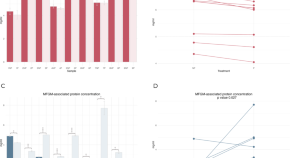
Impact of holder pasteurization on protein and eNAMPT/Visfatin content in human breast milk
- Annalisa Givonetti
- Chiara Galantin
- Maria Cavaletto
News and Comment

Limiting babies’ sugar intake protects them against chronic diseases
Post-war rationing in the UK in 1953 facilitated a natural experiment that now reveals that restricting sugar intake in early life reduces the risk of diabetes and hypertension.
- Karen O’Leary

The time has come to reconsider the quantitative sugar guidelines and related policies
This commentary critiques current sugar intake guidelines, suggesting they oversimplify a complex issue and may lead to unintended outcomes. It advocates for reducing sugar-sweetened beverages, promoting healthy dietary patterns, and recognizing the diverse roles of sugars in foods. The piece calls for a more practical and sustainable approach to public health messaging, aiming for more effective dietary strategies that reflect the complexity of nutritional needs and food sources.
- Jimmy Chun Yu Louie

Diabetes risk soars for adults who had a sweet tooth as kids
Study of 1950s sugar rationing in the United Kingdom also suggests risk to babies whose mums ate a high-sugar diet during pregnancy.
- Heidi Ledford
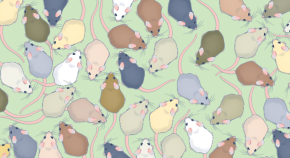
The complex effects of dietary restriction on longevity and health
- Claire Greenhill
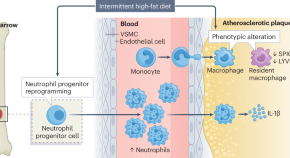
Lower your cholesterol early, and stick with it!
Consumption of a high-fat diet leads to the progressive growth of atherosclerotic lesions. Two new studies document that, despite similar overall exposure to high-fat diet over a lifetime, an intermittent consumption of high-fat diet early in life accelerates atherosclerosis compared with continuous consumption of a high-fat diet. The mechanisms for accelerated atherosclerosis include reprogramming of macrophages and neutrophils.
- Filip K. Swirski
- Christoph J. Binder
Quick links
- Explore articles by subject
- Guide to authors
- Editorial policies
Nutrition Research News
Top headlines, latest headlines.
- More Calories -- More Consumption?
- New Neurons That Suppress Food Intake
- Targeting a Brain Enzyme to Curb Obesity
- Weighty Battle With Chronic Pain: Healthy Diet
- Visceral Fat Linked to Future Alzheimer's
- Confinement: How We Smell and Feel About Food
- Fatty Foods, Mental Stress: Cocoa May Help
- More Effective Treatment for CVD
- How Obesity Causes Diabetes: Stress Hormones?
- How the Brain Handles Hunger
Earlier Headlines
Monday, november 4, 2024.
- High Levels of Omega-3, Omega-6 May Protect Against Cancer
- How the Keto Diet Could One Day Treat Autoimmune Disorders
- New Research Identifies Ways to Protect Neurons from the Negative Effect of High-Fat Diet on Multiple Sclerosis Progression
Thursday, October 31, 2024
- Study Demonstrates Efficacy of Iron Supplements for Children Living With HIV
- The Harmful Frequency and Reach of Unhealthy Foods on Social Media
Wednesday, October 23, 2024
- The Decision to Eat May Come Down to These Three Neurons
Thursday, October 10, 2024
- Coffee During Pregnancy Safe for Baby's Brain Development, Study Suggests
Wednesday, October 2, 2024
- Eyes on the Fries: How Our Vision Creates a Food Trend
Thursday, September 19, 2024
- Food Fussiness a Largely Genetic Trait from Toddlerhood to Adolescence
- Calorie Labels on Alcohol Might Help Some Drinkers Maintain a Healthier Weight
Wednesday, September 18, 2024
- Can the MIND Diet Lower the Risk of Memory Problems Later in Life?
Tuesday, September 17, 2024
- Shrinking the Pint Can Reduce Beer Sales by Almost 10%
Friday, September 13, 2024
- Babies Born to Women Consuming a High Fat, Sugary Diet at Greater Risk of Cardiovascular Disease and Diabetes in Later Life
Tuesday, September 10, 2024
- Unaffordable Food Putting Mums-to-Be at Risk
Thursday, August 29, 2024
- A Groundbreaking Study Describes a New Molecular Pathway Involved in the Control of Reproduction
Thursday, August 22, 2024
- Taking a Trip Down Memory Lane Could Be the Key to Drinking Less Alcohol
Tuesday, August 20, 2024
- Mother's Gut Microbiome During Pregnancy Shapes Baby's Brain Development
Tuesday, August 13, 2024
- Swipe Up! Health Apps Deliver Real Results En Masse
Monday, August 12, 2024
- Parents' Eating Behavior Influences How Their Children Respond to Food
Thursday, August 1, 2024
- Study Examines Effect of Fish Oil in Older Adults' Brains
Tuesday, July 30, 2024
- Peer Influence Can Promote Healthier Shopping Habits, Study Reveals
Monday, July 22, 2024
- Boosting Fruit Intake During Midlife Can Ward Off Late-Life Blues
Friday, July 19, 2024
- Morals Are Key to Consumer Views on Lab-Grown Meat, Study Finds
Tuesday, July 16, 2024
- Evening Activity for Better Sleep
- Food Aroma Study May Help Explain Why Meals Taste Bad in Space
Wednesday, July 10, 2024
- Researchers Pinpoint Brain Cells That Delay First Bite of Food
Wednesday, July 3, 2024
- New Study on Children and Food: Fruit Chunks in Yogurt Are a Turn Off for One Age Group in Particular
Tuesday, July 2, 2024
- Genetic Study Points to Oxytocin as Possible Treatment for Obesity and Postnatal Depression
Friday, June 28, 2024
- New Model Could Help Provide Expectant Mothers a Clearer Path to Safe Fish Consumption
Thursday, June 27, 2024
- Emotional Overeating Fed by Temperament, Caregivers' Reactions to Children's Emotions
Wednesday, June 26, 2024
- 'A Hearty Debate' Concludes Plant-Based Meat Alternatives Are Healthier for Your Heart Than Meat
Monday, June 17, 2024
- A High-Fat Diet May Fuel Anxiety
Friday, June 14, 2024
- Vitamin B6: New Compound Delays Degradation
Monday, June 10, 2024
- Testing Immune Cells in the Placenta May Indicate the Health of Fetal Brain Immune Cells
Thursday, June 6, 2024
- Omega-3 Therapy Prevents Birth-Related Brain Injury in Newborn Rodents
- New Home-Administered Treatment for Binge Eating Disorder Shows Promising Results
Wednesday, June 5, 2024
- Teens With Later Sleep Schedules Are Less Active, Eat More Carbohydrates
- Poor Quality Diet Makes Our Brains Sad
Tuesday, May 28, 2024
- Binge-Eating Disorder Not as Transient as Previously Thought
Wednesday, May 22, 2024
- Eating More Ultra-Processed Foods Tied to Cognitive Decline, Stroke, According to Study
Tuesday, May 21, 2024
- Food for Thought: Study Links Key Nutrients With Slower Brain Aging
Thursday, May 16, 2024
- Unique Brain Circuit Is Linked to Body Mass Index
- Why Do We Overindulge?
Wednesday, May 15, 2024
- 'Trojan Horse' Weight Loss Drug More Effective Than Available Therapies
Monday, May 6, 2024
- Improved Nutrition, Sanitation Linked to Beneficial Changes in Child Stress and Epigenetic Programming
Wednesday, May 1, 2024
- Nutrient Research Reveals Pathway for Treating Brain Disorders
Tuesday, April 30, 2024
- An Omega-6 Fatty Acid May Reduce the Risk for Bipolar Disorder
Monday, April 29, 2024
- Breakthrough in Brown Fat Research: Researchers Have Found Brown Fat's 'off-Switch'
Wednesday, April 24, 2024
- Use of Acid Reflux Drugs Linked to Higher Risk of Migraine
- Neurons Spoil Your Appetite
- New Research Shows 'profound' Link Between Dietary Choices and Brain Health
Monday, April 15, 2024
- Take It from the Rats: A Junk Food Diet Can Cause Long-Term Damage to Adolescent Brains
Thursday, April 4, 2024
- Feeding the Lonely Brain
Tuesday, April 2, 2024
- Even Moderate Alcohol Usage During Pregnancy Linked to Birth Abnormalities
- Blended Antioxidant Supplement Improves Cognition and Memory in Aged Mice
Monday, April 1, 2024
- Pilot Study Shows Ketogenic Diet Improves Severe Mental Illness
Wednesday, March 20, 2024
- Metformin During Pregnancy Affects the Brain Development in Offspring Mice, Study Finds
- Craving Snacks After a Meal? It Might Be Food-Seeking Neurons, Not an Overactive Appetite
- Keto Diet Prevents Early Memory Decline in Mice
Monday, March 18, 2024
- Deciphering the Role of Bitter and Astringent Polyphenols in Promoting Well-Being
Friday, March 15, 2024
- Fatty Food Before Surgery May Impair Memory in Old, Young Adults
Thursday, March 14, 2024
- A Healthier Diet Is Linked With a Slower Pace of Aging, Reduced Dementia Risk, Study Shows
Wednesday, March 13, 2024
- Middle-Age Obesity Is Caused by Changes in the Shape of Neurons in the Brain
Monday, March 11, 2024
- AI-Generated Food Images Look Tastier Than Real Ones
Wednesday, March 6, 2024
- Consuming Refined Carbs Might Be Linked to Perceived Facial Attractiveness
- Too Little Sleep Raises Risk of Type 2 Diabetes, New Study Finds
Friday, March 1, 2024
- Study Results Show 25% of Pregnant People Are Not Getting Enough Omega-3 Fatty Acids from Their Diet or Dietary Supplements

Tuesday, February 27, 2024
- Living Near Pubs, Bars and Fast-Food Restaurants Could Be Bad for Heart Health
Tuesday, February 20, 2024
- Avid Appetite in Childhood Linked to Later Eating Disorder Symptoms
- Could Ultra-Processed Foods Be the New 'silent' Killer?
Friday, February 16, 2024
- Why Do(n't) People Support Being Nudged Towards Healthier Diets?
Thursday, February 15, 2024
- Protein-Rich Breakfast Boosts Satiety and Concentration
- Helping Caregivers Help People With Dementia Eat at Home
Tuesday, February 13, 2024
- A Closer Look at Cannabis Use and Binge Eating
Monday, January 29, 2024
- Study Urges People to Think Twice Before Going on a Diet
Wednesday, January 24, 2024
- 'Furry Fruit' Improves Mental Health -- Fast
Thursday, January 18, 2024
- Removing Largest Serving Sizes of Wine Decreases Alcohol Consumption, Study Finds
- New Gut-Brain Circuits Found for Sugar and Fat Cravings
Saturday, January 13, 2024
- Early Study Shows Health Benefits of Creative Arts Therapies and Nutrition Education for Postmenopausal Women
Thursday, January 11, 2024
- Scientists Identify How Dietary Restriction Slows Brain Aging and Increases Lifespan
Monday, January 8, 2024
- Drugs Used to Treat Type 2 Diabetes Reduce Alcohol Cravings, Use in Individuals With Obesity
Monday, December 18, 2023
- Parents' Top Resolutions: More Patience, Less Time on Phones
Tuesday, December 12, 2023
- Fat Flies Live Longer on a Diet at Any Age
Monday, December 4, 2023
- Survey Finds Americans Struggle to Maintain Healthy Habits During the Holiday Season
Friday, December 1, 2023
- How Pre And Postnatal B-12 Vitamins Improve Breast Milk Vitamin B-12 Levels, Which Supports Infant Brain Development
Tuesday, November 28, 2023
- Fat Cells Help Repair Damaged Nerves
Monday, November 27, 2023
- Scientist Discovers Potential Brain Link Between Stress, Emotional Eating
Wednesday, November 22, 2023
- From the First Bite, Our Sense of Taste Helps Pace Our Eating
Friday, November 17, 2023
- Following a Mediterranean Diet Reduces the Risk of Cognitive Decline in Older People
Thursday, November 16, 2023
- Hunger Hormones Impact Decision-Making Brain Area to Drive Behavior
Monday, November 13, 2023
- Study Finds Melatonin Use Soaring Among Youth
Tuesday, November 7, 2023
- Obesity Linked to Neurodegeneration Through Insulin Resistance
Tuesday, October 24, 2023
- Children as Young as Four Eat More When Bored
Friday, October 20, 2023
- Women With a Heart Healthy Diet in Midlife Are Less Likely to Report Cognitive Decline Later
Wednesday, October 11, 2023
- Jet Lag Disorder Associated With Shift Work Can Lead to Brain Changes Increasing Appetite
Tuesday, October 10, 2023
- How Plant-Derived Nutrients Can Affect the Gut and Brain
Monday, October 9, 2023
- Scientists Says Identifying Some Foods as Addictive Could Shift Attitudes, Stimulate Research
Wednesday, October 4, 2023
- Being a Vegetarian May Be Partly in Your Genes
Monday, October 2, 2023
- Discrimination Alters Brain-Gut 'crosstalk,' Prompting Poor Food Choices and Increased Health Risks
Wednesday, September 27, 2023
- Saturated Fat May Interfere With Creating Memories in Aged Brain
- LATEST NEWS
- Top Science
- Top Physical/Tech
- Top Environment
- Top Society/Education
- Health & Medicine
- Mind & Brain
- Disorders and Syndromes
- ADD and ADHD
- Alzheimer's
- Bipolar Disorder
- Borderline Personality Disorder
- Brain Injury
- Hearing Impairment
- Huntington's Disease
- Mad Cow Disease
- Multiple Sclerosis
- Obstructive Sleep Apnea
- Parkinson's
- Schizophrenia
- Sleep Disorders
- Education & Learning
- Brain-Computer Interfaces
- Educational Psychology
- Infant and Preschool Learning
- Intelligence
- K-12 Education
- Language Acquisition
- Learning Disorders
- Illegal Drugs
- Crystal Meth
- Psychedelic Drugs
- Living Well
- Anger Management
- Child Development
- Consumer Behavior
- Dieting and Weight Control
- Gender Difference
- Nutrition Research
- Racial Issues
- Relationships
- Spirituality
- Mental Health
- Eating Disorders
- Smoking Addiction
- Neuroscience
- Child Psychology
- Social Psychology
- Space & Time
- Matter & Energy
- Computers & Math
- Plants & Animals
- Earth & Climate
- Fossils & Ruins
- Science & Society
- Business & Industry
Strange & Offbeat
- Can the Heart Heal Itself? New Study Says It Can
- Tinkering With 'Clockwork' Mechanisms of Life
- Quantum Teleportation Over Busy Internet Cables
- Mysteries of Icy Ocean Worlds
- Safer Spuds: Removing Toxins from Potatoes
- Gruel Eaten by Early Neolithic Farmers
- Dark Energy 'Doesn't Exist'
- Nerve Regeneration After Spinal Cord Injury
- Laser-Based Artificial Neuron: Lightning Speed
- Large Hadron Collider Regularly Makes Magic
Trending Topics
An official website of the United States government
Official websites use .gov A .gov website belongs to an official government organization in the United States.
Secure .gov websites use HTTPS A lock ( Lock Locked padlock icon ) or https:// means you've safely connected to the .gov website. Share sensitive information only on official, secure websites.
- Publications
- Account settings
- Advanced Search
- Journal List

Advances in Nutrition: Opportunities and Challenges in 2022
Francisco j pérez-cano.
- Author information
- Article notes
- Copyright and License information
Received 2023 Apr 21; Accepted 2023 Apr 23; Collection date 2023 May.
Licensee MDPI, Basel, Switzerland. This article is an open access article distributed under the terms and conditions of the Creative Commons Attribution (CC BY) license ( https://creativecommons.org/licenses/by/4.0/ ).
Many aspects of how food and diet can improve individual health, performance, and wellbeing remain to be discovered. It is necessary to know the exact composition and nutrient availability of diets (food types, preparation, combinations, etc.), the characteristics of individuals (genetics, microbiome, physiological or pathophysiological status, age, etc.), as well as those of the environment that surrounds them. In this sense, this Special Issue entitled “Advances in Nutrition: Opportunities and Challenges in 2022”, edited by Prof. Dr. Philip J. Atherton, Prof. Dr. Ina Bergheim, Prof. Dr. M. Luisa Bonet, Prof. Dr. David C. Nieman, and Dr. Francisco J. Pérez-Cano, has focused on aspects of nutrition and nutritional sciences that are already at the center of current concerns, and which may help humans to face envisaged social and health scenarios in the coming years. The research into nutrition has evolved remarkably in recent years, mostly by applying post-genomic technologies to ascertain mechanisms of nutrient action, including biomarkers of nutrition and health and precision nutrition.
The first aspect to highlight in this Special Issue is the diet–disease relationship. In this sense, metabolic alterations such as diabetes mellitus (DM) and obesity, among others, have in recent years become the most prevalent non-communicable diseases, which in turn provokes a high health-associated cost. For that, there is increasing interest in finding preventive and therapeutic solutions. The review article of Correia et al. [ 1 ], as part of a larger project (PARTNERSHIP, Putting the pAtient fiRsT: maNagemEnt of chRonic diSeases by tHerapeutIc Patient education focused on the management of chronic disorders), consisted of a systematic review and meta-analysis of the efficacy of therapeutic patient education (TPE) interventions for DM and obesity on a wide number of biomedical, psychosocial, and psychological outcomes. Among the expected biomedical findings, such as the evident effectiveness of TPE interventions in improving serum HbA1c levels in DM patients, is noteworthy that these preventive actions seem not to be guided by multidisciplinary teams, in which the nutritionist would play a key role.
Second, besides the role of nutrition on particular diseases, of importance is the life period of the study, especially if the individual has an opportunity for improvement. Thus, nutrition is critical during pregnancy for both the mother’s and the child’s health and their short/long-term outcomes. The article of Lisso et al. [ 2 ] included in this Special Issue evaluated the adherence to nutritional recommendations in Italy during the 3 pregnancy trimesters in 176 women from normal weight and overweight conditions. Overall, the authors found that independently of their weight during pregnancy, Italian women from the study did not adhere to nutritional recommendations, having a lower caloric and certain micronutrients intake but higher protein and sugar intakes. These results, in line with other studies, highlight the importance of providing adequate counseling, including both educational and supplementation interventions if required, to ensure optimal maternal metabolism and fetal growth and development during pregnancy.
Third, in addition to the impact that dietary modifications can have on health and disease management, the use of dietary supplements should be also considered. This Special Issue includes two different in vivo approaches studying dietary supplementations, their impact on microbiota compositions, and also their impact on certain health conditions. On the one hand, as gut microbiota can play a critical role in the progression of Alzheimer disease (AD), Rossell-Cardona et al. [ 3 ] have studied whether the neuroprotective effects of a particular supplement, the spray-dried porcine plasma (SDP), involve the microbiota–gut–brain axis (GBA). The authors found that the dietary supplementation with SDP induced a new intestinal microbial balance that seemed to reduce the intestinal permeability and local and systemic immune and inflammatory responses, which may be involved in the neuroinflammation process of the cognitive decline in these senescent mice model studied. On the other hand, Kienesberger et al. [ 4 ] compared the activity of several probiotics with their derived postbiotics, defined as the preparation of inanimate microorganisms and/or their components that confer a health benefit on their host functionality. The authors found that the postbiotic supernatants had some in vitro antibacterial and antifungal effect and modulated the composition of BALB/c mice microbiota. Both the SDP and the postbiotics assayed are then new products that can exert their actions indirectly through microbiota modulation, thus reinforcing interest in these types of supplements. Further studies in this line to gain a deeper insight into the mechanisms but also to prove their effect on humans are needed in order to guarantee their benefit.
Finally, new biomarkers and methods are appearing to connect nutrition and genotype/phenotype. In this sense, the expression of microRNA (miRNAs) is related to certain pathological conditions, such as asthma. It is plausible that these changes could be influenced by certain nutrients or bioactive compounds. Taken all together, Castro et al. [ 5 ] found some association between the dietary acid load and those miRNAs related to asthma in the exhaled breath condensate of 150 school participants. The results from this interesting approach should be confirmed in future studies.
In summary, in the study of the relationship of food, dietary patterns, and health, some other aspects should be considered. On the one hand, the interaction of diet and genetics, microbiota, age, or lifestyle, such as exercise and performance, is critical. However, on the other hand, the relationship between nutrition, immunity, and infection has to be considered. In addition, many new food sources and products are or could be on the market, and they deserve to be well characterized in terms of their mechanisms of action and their impact on human health. Finally, any new approaches used for identifying or describing the biomarkers or molecular mechanisms involved in the effects of nutrients deserve special attention too. This Special Issue includes five articles which focus on diet and particular challenges, such as prevalent diseases (metabolic diseases), critical physiological periods (gestation), the gut–brain axis, the recently defined microbial modulator concept of “postbiotic”, or diet–miRNAs interaction. All of the articles included in this Special Issue are examples of the current scientific literature in terms of “Advances in Nutrition”, and they highlight the “Opportunities and Challenges” which have been approached throughout 2022.
Acknowledgments
The author thanks the project PID2020-119602RB-I00 funded by the MCIN/AEI/10.13039/501100011033 and the INSA Maria de Maeztu Unit of Excellence grant (CEX2021-001234-M) funded by MICIN/AEI/FEDER, UE.
Conflicts of Interest
The author declares no conflict of interest.
Disclaimer/Publisher’s Note: The statements, opinions and data contained in all publications are solely those of the individual author(s) and contributor(s) and not of MDPI and/or the editor(s). MDPI and/or the editor(s) disclaim responsibility for any injury to people or property resulting from any ideas, methods, instructions or products referred to in the content.
- 1. Correia J.C., Waqas A., Huat T.S., Gariani K., Jornayvaz F.R., Golay A., Pataky Z. Effectiveness of Therapeutic Patient Education Interventions in Obesity and Diabetes: A Systematic Review and Meta-Analysis of Randomized Controlled Trials. Nutrients. 2022;14:3807. doi: 10.3390/nu14183807. [ DOI ] [ PMC free article ] [ PubMed ] [ Google Scholar ]
- 2. Lisso F., Massari M., Gentilucci M., Novielli C., Corti S., Nelva Stellio L., Milazzo R., Troiano E., Schaefer E., Cetin I., et al. Longitudinal Nutritional Intakes in Italian Pregnant Women in Comparison with National Nutritional Guidelines. Nutrients. 2022;14:1944. doi: 10.3390/nu14091944. [ DOI ] [ PMC free article ] [ PubMed ] [ Google Scholar ]
- 3. Rosell-Cardona C., Amat C., Griñán-Ferré C., Polo J., Pallàs M., Pérez-Bosque A., Moretó M., Miró L. The Neuroprotective Effects of Spray-Dried Porcine Plasma Supplementation Involve the Microbiota-Gut-Brain Axis. Nutrients. 2022;14:2211. doi: 10.3390/nu14112211. [ DOI ] [ PMC free article ] [ PubMed ] [ Google Scholar ]
- 4. Kienesberger B., Obermüller B., Singer G., Arneitz C., Gasparella P., Klymiuk I., Horvath A., Stadlbauer V., Magnes C., Zügner E., et al. Insights into the Composition of a Co-Culture of 10 Probiotic Strains (OMNi BiOTiC® AAD10) and Effects of Its Postbiotic Culture Supernatant. Nutrients. 2022;14:1194. doi: 10.3390/nu14061194. [ DOI ] [ PMC free article ] [ PubMed ] [ Google Scholar ]
- 5. Mendes F.C., Paciência I., Cavaleiro Rufo J., Silva D., Delgado L., Moreira A., Moreira P. Dietary Acid Load Modulation of Asthma-Related miRNAs in the Exhaled Breath Condensate of Children. Nutrients. 2022;14:1147. doi: 10.3390/nu14061147. [ DOI ] [ PMC free article ] [ PubMed ] [ Google Scholar ]
- View on publisher site
- PDF (203.1 KB)
- Collections
Similar articles
Cited by other articles, links to ncbi databases.
- Download .nbib .nbib
- Format: AMA APA MLA NLM
Add to Collections
- Brief Report
- Open access
- Published: 30 November 2024
Fundamentals of a healthy and sustainable diet
- Mark Lawrence 1
Nutrition Journal volume 23 , Article number: 150 ( 2024 ) Cite this article
1446 Accesses
3 Altmetric
Metrics details
A healthy and sustainable diet is a prerequisite for population and planetary health. The evidence of associations between dietary patterns and health outcomes has now been synthesised to inform more than 100 national dietary guidelines. Yet, people select foods, not whole dietary patterns, even in the context of following specific diets such as a Mediterranean diet, presenting challenges to researchers, policymakers and practitioners wanting to translate dietary guideline recommendations into food-level selection guidance for citizens. Understanding the fundamentals that underpin healthy and sustainable diets provides a scientific basis for helping navigate these challenges. This paper’s aim is to describe the fundamentals of a healthy and sustainable diet.
The scientific rationale underpinning what is a healthy and sustainable diet is universal. Everyone shares a physiological need for energy and adequate amounts, types and combinations of nutrients. People source their energy and nutrient needs from foods that are themselves sourced from food systems. The physiological need and food systems’ sustainability have been shaped through evolutionary and ecological processes, respectively. This physiological need can be met, and food systems’ sustainability protected, by following three interlinked dietary principles: (i) Variety – to help achieve a nutritionally adequate diet and help protect the biodiversity of food systems. (ii) Balance – to help reduce risk of diet-related non-communicable diseases and excessive use of finite environmental resources and production of greenhouse gas emissions. (iii) Moderation – to help achieve a healthy body weight and avoid wasting finite environmental resources used in providing food surplus to nutritional requirements.
The fundamentals of a healthy and sustainable diet are grounded in evolutionary and ecological processes. They are represented by the dietary principles of variety, balance and moderation and can be applied to inform food-level selection guidance for citizens.
Peer Review reports
A healthy diet is a prerequisite for a healthy life. Everyone shares a physiological need for energy and adequate amounts, types and combinations of nutrients. These are needed for optimal growth, development, maintenance, and repair of the body and as fuel for an active and healthy life [ 1 ]. Conversely, when we are unable to consume a healthy diet, we may be at risk of malnutrition in all its forms which include undernutrition; micronutrient deficiencies; and overweight and obesity and resulting in diet-related noncommunicable diseases (NCDs), such as cardiovascular disease and diabetes [ 2 ]. From these human health and well-being perspectives, a healthy diet has been defined as one that “promotes optimal human growth and development and prevents malnutrition in all its forms” [ 1 ].
Historically, understandings of what constitutes a healthy diet were framed in terms of the consumption of adequate amounts of nutrients to prevent nutrient deficiency diseases [ 3 ]. As nutrition science has evolved we have learned more about associations between dietary patterns, i.e. “the quantities, proportions, variety, or combination of different foods, drinks, and nutrients in diets, and the frequency with which they are habitually consumed” [ 4 ], and health outcomes. The evidence for these associations has now been synthesised to inform more than 100 national dietary guidelines [ 5 ]. Also, there has emerged an increasing amount of evidence showing that what we eat can impact environmental sustainability [ 6 ] and in turn, how environmental disruptions can impact food production systems [ 7 ]. Recognition that there are co-benefits for population and planetary health from adopting diets that are both healthy and sustainable has led to an environmental sustainability dimension being incorporated into many national dietary guidelines [ 8 , 9 , 10 ].
Because people usually select foods, rather than whole dietary patterns, even in the context of following specific diets such as a Mediterranean diet, food policymakers and practitioners seeking to promote healthy and sustainable diets face an intractable challenge of needing to translate dietary guideline recommendations into more accessible food-level advice for citizens. This challenge leads to practical scientific uncertainties with assessing a food’s ‘healthiness’ [ 11 , 12 ] and sustainability [ 13 ]. This paper’s premise is that an understanding of the fundamentals that underpin healthy and sustainable diets provides a scientific basis for helping navigate these uncertainties and informing food selection guidance.
The aim of this paper is to describe the fundamentals of a healthy and sustainable diet. Here, a healthy and sustainable diet is defined as one that promotes optimal human growth and development and prevents malnutrition in all its forms, as well as having low environmental impact to protect food and nutrition security for present and future generations. The paper addresses the aim in three stages. First, it describes the scientific rationale underpinning the links between dietary patterns and health and environmental sustainability outcomes. Second, it synthesises this science into principles for selecting a healthy and sustainable diet. Third, it translates those principles to food selection practice to achieve healthy and sustainable diets. The information presented in this paper relates to the fundamentals of a healthy and sustainable diet for healthy free-living children and adults, not for treating specific health conditions or food safety issues. The ability to select a healthy and sustainable diet based on these fundamentals is dependent on the social, political, environmental and economic determinants of a food system’s structure and operation which influence how and why food is supplied and dietary choices are made [ 14 ].
Scientific rationale underpinning the links between dietary patterns and health and environmental sustainability outcomes
For millions of years, dietary patterns were determined by the availability of a wide range of minimally processed, ‘nutritious’ foods, i.e., foods which are sources of energy and nutrients. Requirements for energy and nutrients were shaped by evolutionary processes as human physiology continually adapted to shifts in dietary patterns [ 15 ]. The food systems from which foods were sourced existed in harmony with ecosystems operating within ‘planetary boundaries’ [ 16 ]. Progressively, food processing innovations were introduced to help protect food safety, reduce spoilage of highly perishable foods, make food more edible at the household level and increase food appeal among citizens.
Modern dietary patterns have transitioned significantly from those present during most of human history [ 17 ]. This transition is a consequence of rapid urbanization and changing lifestyles intertwined with food supply changes characterised particularly by the widespread displacement of minimally processed nutritious foods for ‘ultra-processed foods’ (UPFs). Ultra-processed foods are formulations of ingredients, mostly of exclusive industrial use, typically created by a series of industrial techniques and processes [ 18 ]. Human physiology has not been able to adapt sufficiently to modern dietary pattern exposures, contributing to diet being a leading risk factor for the global burden of disease [ 19 ]. Concurrently, ecosystems have not been able to adapt sufficiently to the operations of modern food systems that are fostering these modern dietary patterns, resulting in food systems being a leading contributor to multiple planetary boundary transgressions [ 6 ].
Synthesising the science into principles for selecting a healthy and sustainable diet
There are three principles that capture the scientific rationale when determining healthy and sustainable diet recommendations, they are dietary: variety; balance; and moderation. The principles need to be considered as a coherent whole with all three being equally important and interlinked. A description of each principle and how they relate to a healthy and sustainable diet follows.
Principle 1: Dietary variety – to help achieve a nutritionally adequate diet and help protect the biodiversity of the food supply
Dietary variety refers to eating a variety of nutritious foods every day. Apart from breast milk in the first six months of life, no single food can supply an appropriate balance of all the nutrients necessary for health. Foods with similar characteristic nutrients and nutrient profiles can be grouped into distinct food groups based on their type and nutrient composition [ 5 ]. Many countries with food-based dietary guidelines identify 4–6 ‘core’ food groups: starchy staples, vegetables, fruits, dairy foods, other ‘protein foods’ and fats and oils [ 5 ]. A nutritionally adequate diet can best be achieved by selecting foods from both across and within the core food groups while prioritising minimally processed foods. These foods should be consumed in amounts recommended in dietary guidelines. A number of countries have undertaken dietary modelling activities to estimate a minimum number and reference size of food serves to be eaten daily from each food group to enable nutrient intake recommendations to be met [ 20 , 21 , 22 ].
From a health perspective, foods can differ substantially in their composition of nutrients and more than an estimated 26,000 other bioactive compounds [ 23 ]. Dietary variety increases the likelihood of consuming an adequate amount, type and combination of nutrients and other bioactive compounds for promoting nutritional health and preventing nutritional deficiency diseases. Synergistic effects among nutrients within and between foods are also instrumental in varied diets positively impacting on health [ 24 ]. Conversely, risk of consuming excessive amounts of certain nutrients and other bioactive compounds that may be present in high concentrations in some foods may be reduced through dietary variety.
From a sustainability perspective, consuming a variety of foods helps to protect the biodiversity of food systems by promoting the production of a wide range of genetically diverse food crops and species. Food crop and species biodiversity helps increase the resilience of food production to threats from pests and diseases in agroecosystems [ 25 ]. This biodiversity may also help contribute to higher and more stable yields as well as lower land clearing and use of harmful agrochemicals [ 26 ].
Principle 2: Dietary balance – to help reduce risk of diet-related non-communicable diseases and excessive use of finite environmental resources and production of greenhouse gas emissions
Dietary balance refers to the relative dietary proportions of the different food groups from which foods are selected. Dietary imbalances arise when the total amount of foods from one or more food groups is consumed in excessive or inadequate amounts relative to the total amount of foods consumed from other food groups. Two dietary imbalances are receiving particular attention. First, in many high-income countries, it is reported there is too low an intake of nutritious plant-source foods relative to animal-source foods [ 27 , 28 ]. Second, in an increasing number of countries around the world, it is reported there is too low an intake of minimally processed nutritious foods relative to UPFs [ 10 , 27 , 29 , 30 , 31 ].
From a health perspective, dietary imbalances are associated with an increased risk of diet-related NCDs such as obesity, cardiovascular disease, certain cancers and diabetes [ 32 , 33 ].
Concerning the imbalance of nutritious plant-source foods relative to animal-source foods, the World Health Organization (WHO) has advised that a healthy diet includes [ 34 ]:
Fruit, vegetables, legumes (e.g. lentils and beans), nuts and whole grains (e.g. unprocessed maize, millet, oats, wheat and brown rice).
At least 400 g (i.e. five portions) of fruit and vegetables per day [ 33 ], excluding potatoes, sweet potatoes, cassava and other starchy roots.
Currently, the WHO (and other UN agencies) does not provide explicit advice on quantities of animal-source foods to include in a healthy and sustainable diet.
Concerning the imbalance of minimally processed nutritious foods relative to UPFs; UPFs are not an essential component of a healthy and sustainable diet. These foods often contribute superfluous energy, ‘risk’ nutrients (added sugar, salt and industrial trans fatty acids) and industrial ingredients, while displacing minimally processed nutritious foods, from dietary patterns [ 18 ]. The WHO has advised that a healthy diet includes [ 34 ]:
Less than 10% of total energy intake from free sugars.
Less than 30% of total energy intake from fats. Unsaturated fats are preferable to saturated fats and trans-fats of all kinds.
Less than 5 g of salt per day. Salt should be iodized.
Reducing excessive dietary intake of UPFs will help correct dietary imbalances not only directly by reducing dietary intake of risk nutrients and industrial ingredients, but also indirectly by increasing dietary intake of minimally processed nutritious foods (assuming the maintenance of a relatively constant dietary energy intake). The amount of UPF that might be accommodated within a healthy diet will vary with a person’s nutrient and energy requirements.
From a sustainability perspective, consuming an excessive amount of animal-source foods relative to nutritious plant-source foods can have significant adverse impacts in terms of greenhouse gas emissions, land use and degradation, water use and pollution linked to nutrient-rich fertilisers, and other environmental indicators [ 35 , 36 ]. Consuming an excessive amount of UPFs relative to minimally processed nutritious foods is associated with biodiversity loss and soil degradation, excessive use of finite environmental resources such as water and food packaging waste, especially plastics [ 37 , 38 ]. These multiple adverse sustainability impacts resulting from excessive consumption of UPFs are even more concerning given these foods are surplus to nutritional requirements.
Principle 3: Dietary moderation – to help achieve a healthy body weight and avoid wasting finite environmental resources used in providing food surplus to nutritional requirements
Dietary moderation refers to consuming enough food to provide for but not exceed the body’s energy needs. It is essential for optimal growth and development (until physical maturity is reached), to maintain a healthy body weight and composition (post-maturity), and to allow for a level of physical activity consistent with long-term good health (all ages) [ 32 ].
From a health perspective, people who consume enough food to provide for but not exceed their body’s energy needs generally have a healthy body weight and composition, and a lower risk of experiencing many diet-related NCDs, such as cardiovascular disease and type 2 diabetes, relative to people whose energy needs are exceeded. People who consume an excessive number and/or size of food serves from each food group beyond that necessary to meet their body’s energy needs may become overweight or obese. Living with overweight or obesity is associated with metabolic problems and an increased risk of many diet-related NCDs [ 39 ]. Conversely, children unable to consume enough food to meet their energy needs may have their growth and development stunted. Stunting is also associated with poor physical, mental and functional health problems [ 40 ]. Adults unable to consume enough food to meet their energy needs over an extended period will suffer from undernutrition and will be vulnerable to adverse health outcomes [ 41 ]. Both stunting and underweight are a consequence of challenges with food accessibility, affordability and availability [ 42 ].
From a sustainability perspective, consuming excessive amounts of food not only contributes to overweight and obesity, but also because it is surplus to meeting the nutritional needs of the consumer it is a waste of the finite environmental resources used in producing, processing, distributing, storing and preparing that food [ 43 ]. Also, excessive food consumption usually involves extra food being purchased and subsequently leading to extra amounts of food packaging requiring disposal.
Translating the dietary principles to inform food-level selection guidance
In practice, determining the precise amounts, types and combinations of foods which constitute a healthy and sustainable diet will vary depending on individual characteristics such as age, gender, lifestage and lifestyle (e.g., work practices which may be sedentary or involve heavy manual labour), as well as cultural, social and environmental circumstances. However, the principles of a healthy and sustainable diet apply equally to individuals and populations around the world. Dietary guidelines have remained broadly consistent over several decades for most countries and they are remarkably similar across the different countries [ 44 ], indicating that the fundamentals of a healthy diet persist over time and place.
Many countries and regions have published a food guide as a graphic representation or visualization of their dietary guidelines to show how the dietary principles of variety, balance and moderation apply to their food supplies, eating habits and social and cultural circumstances [ 30 , 45 , 46 ]. The visual features and certain technical details of these guides vary between countries. Nevertheless, the nutrition science principles that inform these guides are broadly similar. In practical terms these food guides help translate dietary guideline recommendations into food selection advice. Figure 1 presents a synthesis of the common features and technical criteria of national food guides compiled by the Food and Agriculture Organization [ 5 ]. This generic guide promotes the application of each of the dietary principles in the following ways:
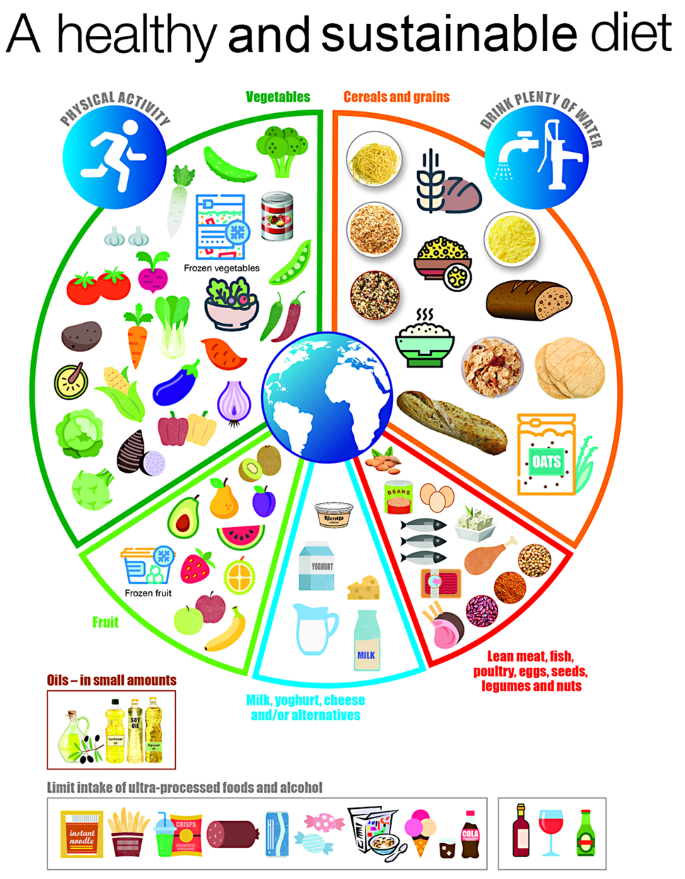
Generic healthy and sustainable food selection guide*. * ‘Designed by minimum graphics’. Copyright for this illustration belongs to the World Health Organization
How the principle might be depicted : Nutritious foods with similar characteristic nutrients and nutrient profiles are grouped together into 5 core food groups (Vegetables; Fruit; Cereals and grains; Lean meat, fish, poultry, eggs, seeds, legumes and nuts; and Milk, yoghurt, cheese and/or alternatives).
How the principle might be described in accompanying text : ‘Each day choose a variety of foods from within each of, and across all, the 5 core food groups.’
How the principle might be depicted : In relation to the balance of nutritious plant-source foods to animal-source foods - the relative size of each core food group segment is broadly indicative of the recommended number of food servings from that group e.g., food groups containing predominantly nutritious plant-source foods will make up a larger proportion of the guide than food groups containing predominantly animal-source foods. In relation to the balance of UPFs to minimally processed, nutritious foods - an ‘Ultra-processed foods’ food group is separated from the 5 core food groups. Defining this non-core food group in terms of the UPF concept provides a stronger conceptual (grounded in evolutionary and ecological processes) and evidential basis than the mostly indeterminate current descriptors such as ‘Extras’ or ‘Discretionary’.
How the principle might be described in accompanying text : ‘Each day choose foods from all 5 core food groups in overall amounts equivalent to the food group proportions set out on the guide’, and ‘Limit intake of UPFs’.
How the principle might be depicted : Illustrations show moderate portion sizes for foods from each food group.
How the principle might be described in accompanying text : ‘Enjoy eating when you’re hungry though stop when you feel full, avoid eating an excessive number and/or size of food serves from each food group and eating when you don’t have a sensation of hunger’(adapted from [ 47 ]).’
The generic food guide is intended to serve as an example and therefore, be flexible with a diversity of foods from around the world illustrated in each of the food groups so that the healthy and sustainable diet principles can be adapted to different food habits, food supplies, eating habits and social and cultural circumstances in each country context.
The food guide illustrates four other considerations for healthy and sustainable diets:
Safe drinking water, preferably tap or portable water or water from other improved sources (e.g., protected boreholes) in preference to other drinks, especially sugar-sweetened beverages [ 48 ] and bottled water, is an integral component of a healthy and sustainable diet.
Food and drinks to limit are predominantly UPFs and alcohol which are nutritionally poor and not an essential component of a healthy diet.
Use small amounts of unsaturated vegetable oil (e.g. olive, soy, sunflower, corn or rapeseed) when required, though many Mediterranean countries report that olive oil makes an important contribution to the health benefits of Mediterranean diets and recommend it be generously included in food preparation and dressings for such diets [ 49 , 50 , 51 ].
Physical activity is an important complement to a healthy diet.
Concluding comments
This manuscript has described how the fundamentals of healthy and sustainable diets are grounded in evolutionary and ecological processes. It reports how the science identifying dietary associations with population and planetary health outcomes can be synthesized into three dietary principles and translated into food-level selection guidance. These principes are commonly represented in national dietary guidelines and food selection guides, albeit with adaptation for cultural, social and environmental circumstances.
The unprecedented rate and scale of change in food systems and environmental settings will continue to outpace the ability of human physiology and ecosystems to adapt and evolve. The bidirectional relationship between dietary patterns and the ecosystems may present an increasing number of trade-offs to consider when preparing dietary guidance for promoting healthy and sustainable diets. For example, there are complex environmental and health considerations when comparing diets containing high amounts of animal-based foods such as meat, chicken and eggs, plant-based foods such as legumes and vegetables which are minimally processed, and novel plant-based food products designed to mimic and replace animal-based foods and which generally are ultra-processed. Plant- and novel plant-based diets typically have smaller environmental footprints than animal-based diets though the alignment of their nutrient profiles with healthy diets is mixed and those containing high amounts of ultra-processed products are associated with longer term adverse health outcomes [ 52 ]. One study modelling dietary recommendations for reducing the amount of animal-source foods in diets, in a large part to mitigate greenhouse gas emissions, showed that dietary intakes of vitamin B12, calcium, iron, and zinc would be below the recommended nutrient intakes for adults and women of reproductive age [ 53 ]. These dynamic circumstances highlight the importance of policymakers being able to discern the level of processing of different types of plant- and novel plant-based foods as well as using nuanced decision-making approaches to consider the range of environmental and health benefits and risks of these foods. A future priority will be constant investigation of associations between dietary patterns and health and sustainability outcomes as well as ongoing review of the evidence base that informs dietary guidelines.
Into the future, guidance on healthy and sustainable diets will need to continue to be based on the synthesis of the best available evidence of associations between dietary patterns and physiological, and increasingly planetary, health outcomes. Yet, dietary guidelines do not speak for themselves. The investment in their preparation will need to extend to investment in their promulgation to nutrition researchers, policymakers and practitioners, and their subsequent translation into food-level selection guidance for citizens.
Data availability
No datasets were generated or analysed during the current study.
Abbreviations
Noncommunicable diseases
- Ultra-processed foods
World Health Organization
Kumanyika S, Afshin A, Arimond M, Lawrence M, McNaughton SA, Nishida C. Approaches to defining healthy diets: a background paper for the International Expert Consultation on sustainable healthy diets. Food Nutr Bull. 2020;41(2suppl):S7–30.
Article Google Scholar
World Health Organization. Fact sheets - Malnutrition [Internet]. 2024 [cited 2024 Jul 29]. https://www.who.int/news-room/fact-sheets/detail/malnutrition
Mozaffarian D, Rosenberg I, Uauy R. History of modern nutrition science—implications for current research, dietary guidelines, and food policy. BMJ. 2018;361:k2392.
Article PubMed PubMed Central Google Scholar
U.S. Department of Agriculture. A Series of Systematic Reviews on the Relationship Between Dietary Patterns and Health Outcomes [Internet]. 2014 [cited 2024 Jul 31]. https://nesr.usda.gov/sites/default/files/2019-06/DietaryPatternsReport-FullFinal2.pdf
FAO. Food and Agriculture Organization of the United Nations. 2024 [cited 2024 Jul 31]. Food-based dietary guidelines. http://www.fao.org/nutrition/education/food-dietary-guidelines/home/en/
Rockström J, Edenhofer O, Gaertner J, DeClerck F. Planet-proofing the global food system. Nat Food. 2020;1(1):3–5.
Intergovernmental Panel on Climate Change. IPCC Special Report on Climate Change, Desertification, Land Degradation, Sustainable Land Management, Food Security, and Greenhouse gas fluxes in Terrestrial Ecosystems: Summary for policy makers [Internet]. 2019 [cited 2024 Jul 25]. https://www.ipcc.ch/srccl/
James-Martin G, Baird DL, Hendrie GA, Bogard J, Anastasiou K, Brooker PG, et al. Environmental sustainability in national food-based dietary guidelines: a global review. Lancet Planet Health. 2022;6(12):e977–86.
Article PubMed Google Scholar
FAO. Food and Agriculture Organization of the United Nations. 2024 [cited 2024 Jul 31]. Dietary guidelines and sustainability. http://www.fao.org/nutrition/education/food-dietary-guidelines/background/sustainable-dietary-guidelines/en/
FAO, University of Oxford. Plates, pyramids and planets Developments in national healthy and sustainable dietary guidelines: a state of play assessmentt [Internet]. Food and Agriculture Organization and University of Oxford; 2016 [cited 2024 Jul 25]. https://openknowledge.fao.org/server/api/core/bitstreams/4986aec2-a354-4497-8afc-94b562a53e53/content
Cooper SL, Pelly FE, Lowe JB. Construct and criterion-related validation of nutrient profiling models: a systematic review of the literature. Appetite. 2016;100:26–40.
Lawrence MA, Dickie S, Woods JL. Do nutrient-based front-of-Pack labelling schemes support or undermine Food-based Dietary Guideline recommendations? Lessons from the Australian Health Star Rating System. Nutrients. 2018;10(1):32.
Lawrence M. Challenges associated with greenhouse gas emissions-related food guidance. Nat Food. 2024;5(6):459–60.
HLPE. Nutrition and food systems. A report by the High Level Panel of Experts on Food Security and Nutrition of the Committee on World Food Security. [Internet]. Rome; 2017 [cited 2024 Jul 25]. https://www.fao.org/policy-support/tools-and-publications/resources-details/en/c/1155796/
Raubenheimer D, Simpson SJ. Nutritional Ecology and Human Health. Annu Rev Nutr. 2016;36:603–26.
Article CAS PubMed Google Scholar
Rockström J, Steffen W, Noone K, Persson Å, Chapin FSI, Lambin E et al. Planetary Boundaries: Exploring the Safe Operating Space for Humanity. Ecol Soc [Internet]. 2009 Nov 18 [cited 2024 Jul 31];14(2). https://www.ecologyandsociety.org/vol14/iss2/art32/
Eaton SB, Eaton SB. Paleolithic vs. modern diets–selected pathophysiological implications. Eur J Nutr. 2000;39(2):67–70.
Monteiro CA, Cannon G, Levy RB, Moubarac JC, Louzada ML, Rauber F, et al. Ultra-processed foods: what they are and how to identify them. Public Health Nutr. 2019;22(5):936–41.
Afshin A, Sur PJ, Fay KA, Cornaby L, Ferrara G, Salama JS, et al. Health effects of dietary risks in 195 countries, 1990–2017: a systematic analysis for the global burden of Disease Study 2017. Lancet. 2019;393(10184):1958–72.
Mariotti F, Havard S, Morise A, Nadaud P, Sirot V, Wetzler S, et al. Perspective: modeling healthy eating patterns for food-based Dietary Guidelines-Scientific concepts, methodological processes, limitations, and lessons. Adv Nutr Bethesda Md. 2021;12(3):590–9.
Commonwealth of Australia. A modelling system to inform the revision of the Australian guide to healthy eating. [Internet]. Canberra: Commonwealth of Australia: National Health and Medical Research Council; 2021 [cited 2024 Jul 25]. https://www.eatforhealth.gov.au/sites/default/files/files/the_guidelines/n55c_dietary_guidelines_food_modelling.pdf
U.S. Department of Agriculture. Dietary Guidelines for Americans. 2020 [cited 2024 Jul 25]. Food Pattern Modeling | Dietary Guidelines for Americans. https://www.dietaryguidelines.gov/2020-advisory-committee-report/food-pattern-modeling
Barabási AL, Menichetti G, Loscalzo J. The unmapped chemical complexity of our diet. Nat Food. 2020;1(1):33–7.
Tapsell LC, Neale EP, Satija A, Hu FB. Foods, nutrients, and dietary patterns: interconnections and implications for Dietary guidelines. Adv Nutr Bethesda Md. 2016;7(3):445–54.
Article CAS Google Scholar
Ratnadass A, Fernandes P, Avelino J, Habib R. Plant species diversity for sustainable management of crop pests and diseases in agroecosystems: a review. Agron Sustain Dev. 2012;32(1):273–303.
Renard D, Tilman D. Cultivate biodiversity to harvest food security and sustainability. Curr Biol. 2021;31(19):R1154–8.
FAO and WHO. Sustainable healthy diets - Guiding principles [Internet]. Rome. 2019 [cited 2024 Jul 25]. https://www.who.int/publications/i/item/9789241516648
Willett W, Rockström J, Loken B, Springmann M, Lang T, Vermeulen S, et al. Food in the Anthropocene: the EAT–Lancet Commission on healthy diets from sustainable food systems. Lancet. 2019;393(10170):447–92.
FAO, IFAD, UNICEF, WFP and WHO. The State of Food Security and Nutrition in the World [Internet]. Rome; 2024 [cited 2024 Jul 31]. https://www.fao.org/publications/home/fao-flagship-publications/the-state-of-food-security-and-nutrition-in-the-world/en
Indian Council of Medical Research. Dietary Guidelines for Indians [Internet]. 2024 [cited 2024 Jul 31]. https://main.icmr.nic.in/sites/default/files/upload_documents/DGI_07th_May_2024_fin.pdf
Baker P, Machado P, Santos T, Sievert K, Backholer K, Hadjikakou M, et al. Ultra-processed foods and the nutrition transition: global, regional and national trends, food systems transformations and political economy drivers. Obes Rev off J Int Assoc Study Obes. 2020;21(12):e13126.
National Health and Medical Research Council. Australian Dietary Guidelines [Internet]. 2013 [cited 2024 Jul 31]. https://www.eatforhealth.gov.au/sites/default/files/2022-09/n55_australian_dietary_guidelines.pdf
World Health Organization. Diet, nutrition and the prevention of chronic diseases: report of a joint WHO/FAO expert consultation. [Internet]. Geneva: World Health Organisation; 2003 [cited 2024 Jul 31]. 149 p. (WHO technical report series). https://iris.who.int/handle/10665/42665
World Health Organization. Fact sheets - Healthy Diet [Internet]. 2020 [cited 2024 Aug 8]. https://www.who.int/news-room/fact-sheets/detail/healthy-diet
Clark M, Macdiarmid J, Jones AD, Ranganathan J, Herrero M, Fanzo J. The role of healthy diets in environmentally sustainable Food systems. Food Nutr Bull. 2020;41(2suppl):S31–58.
Espinosa-Marrón A, Adams K, Sinno L, Cantu-Aldana A, Tamez M, Marrero A et al. Environmental Impact of Animal-Based Food Production and the Feasibility of a Shift Toward Sustainable Plant-Based Diets in the United States. Front Sustain [Internet]. 2022 May 4 [cited 2024 Jul 25];3. https://www.frontiersin.org/journals/sustainability/articles/ https://doi.org/10.3389/frsus.2022.841106/full
Fardet A, Rock E. Ultra-processed Foods and Food System sustainability: what are the links? Sustainability. 2020;12(15):6280.
Leite FHM, Khandpur N, Andrade GC, Anastasiou K, Baker P, Lawrence M, et al. Ultra-processed foods should be central to global food systems dialogue and action on biodiversity. BMJ Glob Health. 2022;7(3):e008269.
GBD 2015 Obesity Collaborators. Health effects of overweight and obesity in 195 countries over 25 years. N Engl J Med. 2017;377(1):13–27.
de Onis M, Branca F. Childhood stunting: a global perspective. Matern Child Nutr. 2016;12(1):12–26.
Prospective Studies Collaboration. Body-mass index and cause-specific mortality in 900 000 adults: collaborative analyses of 57 prospective studies. Lancet. 2009;373(9669):1083–96.
Article PubMed Central Google Scholar
HLPE. Food security and nutrition: building a global narrative towards 2030. Rome: a report by the high level panel of experts on. Food Security and Nutrition of the Committee on World Food Security; 2020.
Sundin N, Rosell M, Eriksson M, Jensen C, Bianchi M. The climate impact of excess food intake - an avoidable environmental burden. Resour Conserv Recycl. 2021;174:105777.
Herforth A, Arimond M, Álvarez-Sánchez C, Coates J, Christianson K, Muehlhoff E. A Global Review of Food-based Dietary guidelines. Adv Nutr Bethesda Md. 2019;10(4):590–605.
FAO. Food and Agriculture Organization of the United Nations. 2024 [cited 2024 Jul 31]. Food-based dietary guidelines - Sweden. http://www.fao.org/nutrition/education/food-dietary-guidelines/regions/sweden/en/
Agencia de Salud Pública de Cataluña. Catalan Food Based Dietary Guideline (2020)(Catalan) – Sustainability [Internet]. Barcelona; 2019 [cited 2024 Jul 31]. https://icdasustainability.org/report/catalan-food-based-dietary-guideline-2020catalan/
Durrer Schutz D, Busetto L, Dicker D, Farpour-Lambert N, Pryke R, Toplak H, et al. European practical and patient-centred guidelines for adult obesity management in primary care. Obes Facts. 2019;12(1):40–66.
World Health Organization. Guidelines for drinking-water quality: fourth edition incorporating first addendum [Internet]. 4th ed + 1st add. Geneva: World Health Organization; 2017 [cited 2024 Jul 25]. 541 p. https://iris.who.int/handle/10665/254637
FAO. Food and Agriculture Organization of the United Nations. 2024 [cited 2024 Jul 25]. Food-based dietary guidelines - Spain. http://www.fao.org/nutrition/education/food-dietary-guidelines/regions/spain/en/
FAO. Food and Agriculture Organization of the United Nations. 2024 [cited 2024 Jul 25]. Food-based dietary guidelines - Greece. http://www.fao.org/nutrition/education/food-dietary-guidelines/regions/greece/en/
FAO. Food and Agriculture Organization of the United Nations. 2024 [cited 2024 Jul 25]. Food-based dietary guidelines - Cyprus. http://www.fao.org/nutrition/education/food-dietary-guidelines/regions/cyprus/en/
Nájera Espinosa S, Hadida G, Jelmar Sietsma A, Alae-Carew C, Turner G, Green R et al. Mapping the evidence of novel plant-based foods: a systematic review of nutritional, health, and environmental impacts in high-income countries. Nutr Rev. 2024:nuae031. https://doi.org/10.1093/nutrit/nuae031 .
Beal T, Ortenzi F, Fanzo J. Estimated micronutrient shortfalls of the EAT-Lancet planetary health diet. Lancet Planet Health. 2023;7(3):e233–7.
Download references
Acknowledgements
M.L. received support from the WHO for the preparation of this paper, and the WHO’s permission to include the food selection guide illustration drafted during this developmental work. The funders had no role in study design, data collection and analysis, decision to publish or preparation of the manuscript. Ms Ana Paula Cardoso Richter, Deakin University, Geelong, VIC, Australia, provided administrative and technical support for the preparation of the manuscript.
M.L. received support from the Australian Research Council Discovery Project titled ‘Reforming evidence synthesis and translation for food and nutrition policy’ (DP190101323). M.L. also received support from the WHO for the preparation of this paper, and the WHO’s permission to include the food selection guide illustration drafted during this developmental work. The funders had no role in study design, data collection and analysis, decision to publish or preparation of the manuscript.
Author information
Authors and affiliations.
Institute for Physical Activity and Nutrition, School of Exercise and Nutrition Sciences, Deakin University, Geelong, VIC, Australia
Mark Lawrence
You can also search for this author in PubMed Google Scholar
Contributions
ML conceived and wrote the paper.
Corresponding author
Correspondence to Mark Lawrence .
Ethics declarations
Ethics approval and consent to participate.
Not applicable.
Consent for publication
Competing interests.
M.L. is a Board member of Food Standards Australia New Zealand (FSANZ). The findings and views presented in this manuscript are those of ML’s alone and do not necessarily reflect the findings or views of the Australian Government or FSANZ or the WHO.
Additional information
Publisher’s note.
Springer Nature remains neutral with regard to jurisdictional claims in published maps and institutional affiliations.
Rights and permissions
Open Access This article is licensed under a Creative Commons Attribution 4.0 International License, which permits use, sharing, adaptation, distribution and reproduction in any medium or format, as long as you give appropriate credit to the original author(s) and the source, provide a link to the Creative Commons licence, and indicate if changes were made. The images or other third party material in this article are included in the article’s Creative Commons licence, unless indicated otherwise in a credit line to the material. If material is not included in the article’s Creative Commons licence and your intended use is not permitted by statutory regulation or exceeds the permitted use, you will need to obtain permission directly from the copyright holder. To view a copy of this licence, visit http://creativecommons.org/licenses/by/4.0/ .
Reprints and permissions
About this article
Cite this article.
Lawrence, M. Fundamentals of a healthy and sustainable diet. Nutr J 23 , 150 (2024). https://doi.org/10.1186/s12937-024-01049-6
Download citation
Received : 24 May 2024
Accepted : 13 November 2024
Published : 30 November 2024
DOI : https://doi.org/10.1186/s12937-024-01049-6
Share this article
Anyone you share the following link with will be able to read this content:
Sorry, a shareable link is not currently available for this article.
Provided by the Springer Nature SharedIt content-sharing initiative
- Healthy and sustainable diet
- Dietary guidelines
- Dietary variety
- Dietary balance
- Dietary moderation
- Food selection guide
Nutrition Journal
ISSN: 1475-2891
- General enquiries: [email protected]

Delicious Bacon Highlights Food That Enraptures Our Senses but Endangers Our Health
Some foods, no matter how simply prepared, contain many substances linked to disease
Lydia Denworth
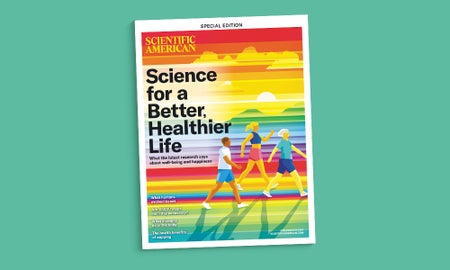
Science for True Well-Being
The latest research is an antidote to toxic quackery and honest confusion about health
Andrea Gawrylewski

$0 for Digital Access
Read all the stories you want.

It’s Actually Healthier to Enjoy Holiday Foods without the Anxiety
Food anxiety can peak during the holidays. Here’s how to manage it and enjoy yourself
Allison Parshall

Artificial Sweetener Erythritol Linked to Blood Clots, Study Warns
A new study suggests a commonly used sugar substitute could increase the risk of blood clots, raising concerns for heart complications
Kate Graham-Shaw

Can Coffee's Effects on Appetite and Digestion Cause Weight Loss?
A new generation of coffee concoctions on social media is putting the spotlight back on the drink’s possible weight-loss effects
Lori Youmshajekian

How the Nutrition Facts Label Has Changed Food in the U.S.
Almost all packaged food sold in the U.S. for the past three decades has sported a Nutrition Facts label, with major consequences for the food system
Xaq Frohlich, The Conversation US
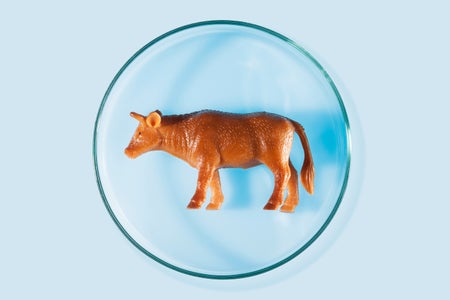
Lab-Grown Meat Is Getting Closer to Tasting Like Real Beef
Cultured meat that tastes and smells more appetizing could enhance public perception of artificial steaks
Helena Kudiabor, Nature magazine

Are Ultra-Processed Foods Really all that Unhealthy?
Processed foods have been blamed for many health problems, but dietary research is tricky and nuanced
Amos Zeeberg, OpenMind Magazine

Can You Eat Cicadas? Can Your Dog Do So?
Here’s what a chef, a vet and two anthropologists have to say about eating periodical cicadas
Meghan Bartels

Could Magnesium and TikTok’s ‘Sleepy Girl Mocktail’ Actually Help You Sleep?
TikTok’s “sleepy girl mocktails” remind us how important magnesium is for sleep and health
Jocelyn Solis-Moreira

Your Body Has Its Own Built-In Ozempic
Popular weight-loss and diabetes drugs, such as Ozempic and Wegovy, target metabolic pathways that gut microbes and food molecules already play a key role in regulating
Christopher Damman, The Conversation US

Ozempic and Other Weight-Loss Drugs Are Sparking a Risky New War on Obesity
The world has launched into an era of injectables not just to treat obesity but to manage weight. Is that all good news?
Arthur Caplan

IMAGES
COMMENTS
Jan 5, 2022 · 2021 has come to a close, take a look back at some trending nutrition research articles from ASN’s four journals: The Journal of Nutrition, The American Journal of Clinical Nutrition, Advances in Nutrition, and Current Developments in Nutrition. Here are 15 articles that were mentioned the most in news and social media this year.
2 days ago · Read about the latest research in nutrition. Answers to questions about nutrition, body weight, herbal and nutritional supplements, and the role of diet in improving and maintaining your health.
6 days ago · Nutrition is the organic process of nourishing or being nourished, including the processes by which an organism assimilates food and uses it for growth and maintenance. ... Latest Research and ...
Dec 17, 2010 · Nutrition Research News. December 22, 2024 ... 2024 — New research shows that adopting a healthy diet can reduce the severity of chronic pain, ... or browse the topics below: Science & Society ...
Advances in Nutrition review finds ultra-processed foods are associated with a higher risk of diabetes, hypertension, obesity, and cardiovascular disease Read More May 30, 2024
4 days ago · Nutrition Journal provides a global platform to disseminate surveillance, epidemiologic, and intervention research relevant to human nutrition. Embracing a ...
A multidisciplinary journal that integrates research on dietary behavior, agronomy and 21st century food science with a focus on human health.
The research into nutrition has evolved remarkably in recent years, mostly by applying post-genomic technologies to ascertain mechanisms of nutrient action, including biomarkers of nutrition and health and precision nutrition. The first aspect to highlight in this Special Issue is the diet–disease relationship.
Nov 30, 2024 · Background A healthy and sustainable diet is a prerequisite for population and planetary health. The evidence of associations between dietary patterns and health outcomes has now been synthesised to inform more than 100 national dietary guidelines. Yet, people select foods, not whole dietary patterns, even in the context of following specific diets such as a Mediterranean diet, presenting ...
Aug 22, 2024 · Nutrition coverage from Scientific American, featuring news and articles about advances in the field. ... The latest research is an antidote to toxic quackery and honest confusion about health ...